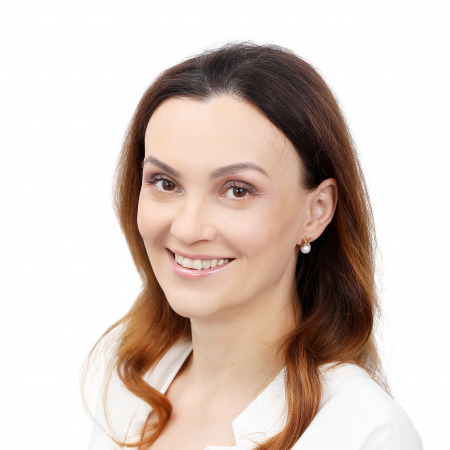Thyroidectomy
Thyroid removal (thyroidectomy) is the surgical removal of all or part of the thyroid gland. Your thyroid gland is a butterfly-shaped gland located at the base of your neck. It produces hormones that control every aspect of your metabolism, from heart rate to calorie-burning rate.
When should a thyroidectomy be performed?
Indications for surgery:
- Thyroid cancer. If thyroid cancer is diagnosed, removing most, if not all, may be the only treatment option;
- Benign enlargement of the thyroid gland (goitre). Removal of all or part of the thyroid gland is an option if the goitre is large, causing discomfort or difficulty breathing or swallowing, and, in some cases, if the goitre causes hyperthyroidism;
- Overactive thyroid gland (hyperthyroidism). If you have problems taking antithyroid drugs and you do not want radioactive iodine therapy, thyroidectomy may be indicated;
- Unspecified or suspicious thyroid nodules. Some thyroid nodules cannot be identified as malignant or benign after analysis of a needle biopsy sample. Specialists may recommend surgery to people with such nodules if they have an increased risk of malignancy;
- Surgery is recommended in cases where the patient develops cancer, but there are contraindications to radioiodine therapy.
What are the contraindications to surgery?
The intervention is minimally traumatic and therefore has a minimum number of contraindications:
- acute infectious diseases;
- chronic pathologies in the acute stage;
- blood clotting disorders.
What types of thyroidectomy are performed?
Which part of the thyroid gland is removed during thyroidectomy depends on the cause of the operation.
There are the following types of thyroidectomy:
- hemithyroidectomy (removal of the part thyroid gland);
- resection of the thyroid gland (removal of most of the thyroid gland);
- thyroidectomy (complete removal of the thyroid gland);
- transoral thyroidectomy (this approach avoids incision in the neck by incision in the mouth);
- endoscopic thyroidectomy with access to the neck (smaller incisions in the neck are used);
- endoscopic thyroidectomy with axillary access (video-assisted surgery performed through access in the axillary region).
How is an "open" thyroidectomy performed?
Before surgical treatment, the patient should consult an endocrine surgeon, undergo an ultrasound of the thyroid gland and fine-needle biopsy, pass blood tests for thyroid hormones. The doctor should be informed in advance about the drugs that the patient takes regularly. It is important to inform about the presence of allergies. As part of the training, a course of antibiotics may also be prescribed.
After a complete examination of the patient, our specialists make decisions about the operation.
The operation is performed under general anaesthesia. The surgeon makes a transverse incision in the neck to provide access to the organ. Carefully examines the formation of the thyroid gland, decides which part of the gland should be removed, and checks the lymph nodes near the gland. Then the thyroid gland is removed. The final part of the operation is suturing of the soft tissues of the neck and installation of drainage (after a day the drainage is removed). Our clinic uses modern, bloodless instruments (electric welding, ligature-free scalpel "LigaShue") to remove the gland, which allows you to perform better "open" thyroidectomy, and according to certain indicators to perform minimally invasive or endoscopic interventions. At the slightest suspicion of cancer, be sure to perform a rapid histological examination, as well as a histological examination of any removed material.
How is endoscopic thyroidectomy performed?
The affected organ is removed not through an open incision in the neck, but access to the axilla or the mouth. Scars are minimal and invisible. The surgeon works with special endoscopic instruments in front of a high-resolution video monitor. The image is magnified many times, which provides excellent visibility and accuracy.
What are the benefits of endoscopic surgery?
- good cosmetic effect - no scar on the neck (as after removal of the thyroid gland through the mouth, transoral method);
- minimal rehabilitation - pain is not pronounced, you can return to normal life the day after surgery;
- excluded risks of damage to blood vessels, nerve endings and other vital anatomical structures;
- excluded risks of complications and recurrence of thyroid disease - the affected organ or part of it are removed completely.
Which method of surgical treatment is suitable for the patient depends on factors such as size, stage, location and type of thyroid tumour. In our clinic, operations are performed according to classic and innovative methods, which minimizes the risk of complications. Only after a detailed examination, our specialists decide on the choice of surgical treatment of the thyroid gland.
How is the recovery period after surgery?
Removal of the thyroid gland is sometimes the only way to improve quality of life and prevent cancer. The patient remains in the hospital under the supervision of specialists for 1-2 days. If no complications are observed, the surgeon removes the drainage tube and releases the patient home. Bandaging is performed for the first 4-6 days. It takes 10-12 days for the patient to fully recover.
After endoscopic surgery to remove the thyroid gland by the axillary method, the period is minimized: in 3-4 hours after the operation, you can theoretically do the usual things.
After the operation, it is necessary to regularly visit an endocrinologist. This is important because removal of the thyroid gland involves lifelong hormone replacement therapy. Note that hormone replacement therapy after thyroid surgery is not always required - all individually. If the cause of the operation was a malignant tumour, the patient is prescribed radioactive iodine therapy.
Bibliography
- Курашвили Л. Р. Руководство к практическим занятиям по биопсийносекционному курсу (клиническая патанатомия): учебное пособие. – М.: Издательский дом Академии Естествознания, 2012. – 74 с
- Черкашин М.А. , Пучков Д.Д., Реут Е.А - Трепан-биопсии солидных опухолей под контролем компьютерной и магнитно-резонансной томографии - «РМЖ» №6 от 27.11.2019 стр. 3-9
- Alei G, Letizia P, Sorvillo V, et al. Lichen sclerosus in patients with squamous cell carcinoma. Our experience with partial penectomy and reconstruction with ventral fenestrated ´ ap. Published online, August, 2012.


